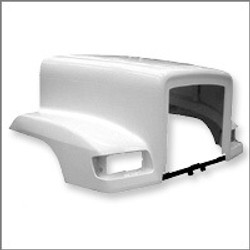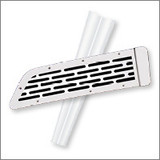The Freightliner FLC120 Hoods & Related product lineup includes a wide range of parts and accessories for the Freightliner FLC120 model truck. This product lineup covers everything from hood emblems and bezels to hood replacement parts and trim, ensuring owners can find the exact components they need to maintain or customize the appearance of their vehicle's front end. With a focus on the Freightliner FLC120, this product lineup offers a comprehensive selection of high-quality parts to help keep your truck looking its best on the road.
Frequently Asked Questions About Freightliner FLC120 Hoods & Related
Will these hoods fit my specific year FLC120, and what are the main differences between model years?
Most aftermarket hoods for the FLC120 are designed to fit models from 1989 through 2003. However, there are important distinctions: pre-1996 models typically have different mounting brackets and may require adapter kits. The hood hinge style changed in 1997, so verify whether you need the older pin-style or newer bolt-on hinges. Always confirm your truck's exact build date and VIN with us before ordering to ensure proper fitment.
What's the actual weight difference between fiberglass and aluminum hoods, and how difficult is installation?
Fiberglass hoods typically weigh 85-110 pounds, while aluminum hoods range from 120-150 pounds depending on design. Installation requires two people and takes approximately 2-4 hours. You'll need basic hand tools, and most hoods come with mounting hardware. The main challenges include aligning the hood properly with fenders and ensuring the latch mechanism engages correctly. Some customers report needing to adjust or shim hinges for perfect alignment.
Do aftermarket hoods come pre-drilled for accessories like bug shields, mirrors, and air horns?
Most aftermarket hoods come with standard mounting holes for factory accessories, but additional drilling is often required for aftermarket bug shields, extra lighting, or custom air horn setups. Fiberglass hoods are easier to drill and modify than aluminum. We recommend using a step drill bit and reinforcement plates for any new holes in fiberglass hoods to prevent cracking around mounting points.
How do I know if I need a set-forward or set-back hood design for my FLC120?
The distinction depends on your engine configuration and front axle placement. Set-forward hoods (extending 10-13 inches beyond the fenders) are typically used on trucks with larger engines or those requiring additional cooling capacity. Set-back hoods (5-7 inch extension) are standard on most highway tractors. Measure from your fender to the front of your current hood, or provide us with your engine model and we can help determine the correct style.
What prep work is required before painting, and what's the typical lifespan of these hoods?
Fiberglass hoods require sanding with 180-220 grit sandpaper, primer application, and may need minor filling of imperfections before painting. Aluminum hoods need etching primer after thorough cleaning. With proper maintenance, fiberglass hoods typically last 10-15 years, while aluminum hoods can last 20+ years. Common issues include stress cracks near hinges on fiberglass (usually after 7-10 years) and corrosion at mounting points on aluminum hoods in salt-heavy regions.

 Freightliner FLC120 Front Fenders & Acc.
Freightliner FLC120 Front Fenders & Acc.
 Freightliner FLC120 Hood Replacement Parts
Freightliner FLC120 Hood Replacement Parts
 Freightliner FLC120 Hood Trim & Accents
Freightliner FLC120 Hood Trim & Accents
 Freightliner FLC120 Winter Fronts & Bug Screens
Freightliner FLC120 Winter Fronts & Bug Screens



